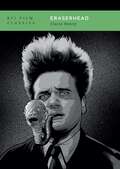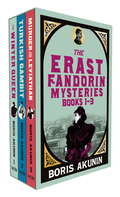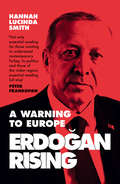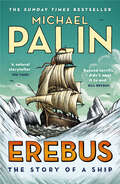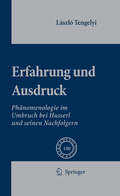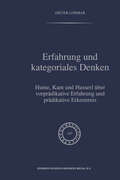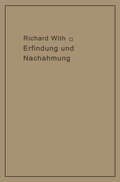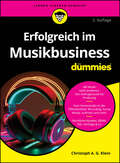- Table View
- List View
Eraserhead (BFI Film Classics)
by Claire HenryA surreal and darkly humorous vision, David Lynch's Eraserhead (1977) has been recognised as a cult classic since its breakout success as a midnight movie in the late 1970s.Claire Henry's study of the film takes us into its netherworld, providing a detailed account of its production history, its exhibition and reception, and its elusive meanings. Using original archival research, she traces how Lynch took his nightmare of Philadelphia to the City of Dreams, infusing his LA-shot film with the industrial cityscapes and sounds of the Callowhill district. Henry then engages with Eraserhead's irresistible inscrutability and advances a fresh interpretation, reframing auteurism to centre Lynch's creative processes as a visual artist and Transcendental Meditation practitioner. Finally, she outlines how Lynch's 'dream of dark and troubling things' became a model midnight movie and later grew in reputation and influence across broader film culture. From the opening chapter on Eraserhead's famous 'baby' to the final chapter on the film's tentacular influence, Henry's compelling and authoritative account offers illuminating new perspectives on the making and meaning of the film and its legacy. Through an in-depth analysis of the film's rich mise en scène, cinematography, sound and its embeddedness in visual art and screen culture, Henry not only affirms the film's significance as Lynch's first feature, but also advances a wider case for appreciating its status as a film classic.
Erasing the Binary Distinction of Developed and Underdeveloped: A Comparative Study of the Emergence of the Large-Scale Steel Industry in Imperial Russia, Imperial Britain, Imperial America, and Colonial India, 1880-1914
by Vinay BahlThis book challenges the binary distinction of developed and underdeveloped in the categorization of any country while proposing to erase this binary with a yardstick of parity. Through a sample comparative historical study focusing on the question of the emergence of the large-scale steel industry (1880-1914) of four chosen countries, two considered "developed" (Imperial UK and Post-colonial Imperial USA) and two considered "underdeveloped" (Imperial Russia and Colonial India), it is shown how this yardstick of parity can be applied without the categorization of societies as either developed or underdeveloped. Print edition not for sale in South Asia (India, Sri Lanka, Nepal, Bangladesh, Pakistan or Bhutan)
Erasing the Binary Distinction of Developed and Underdeveloped: A Comparative Study of the Emergence of the Large-Scale Steel Industry in Imperial Russia, Imperial Britain, Imperial America, and Colonial India, 1880-1914
by Vinay BahlThis book challenges the binary distinction of developed and underdeveloped in the categorization of any country while proposing to erase this binary with a yardstick of parity. Through a sample comparative historical study focusing on the question of the emergence of the large-scale steel industry (1880-1914) of four chosen countries, two considered "developed" (Imperial UK and Post-colonial Imperial USA) and two considered "underdeveloped" (Imperial Russia and Colonial India), it is shown how this yardstick of parity can be applied without the categorization of societies as either developed or underdeveloped. Print edition not for sale in South Asia (India, Sri Lanka, Nepal, Bangladesh, Pakistan or Bhutan)
Erasmus: Intellectual of the 16th Century
by Nathan RonThis book is a sequel to Nathan Ron's Erasmus and the “Other.” Should we consider Erasmus an involved or public intellectual alongside figures such as Machiavelli, Milton, Locke, Voltaire, and Montesquieu? Was Erasmus really an independent intellectual? In Ron's estimation, Erasmus did not fully live up to his professed principles of Christian peace. Despite the anti-war preaching so eminent in his writings, he made no stand against the warlike and expansionist foreign policies of specific European kings of his era, and even praised the glory won by Francis I on the battlefield of Marignano (1515). Furthermore, in the face of Henry VIII’s execution of his beloved Thomas More and John Fisher, and the atrocities committed by the Spanish against indigenous peoples in the New World, Erasmus preferred self-censorship to expressions of protest or criticism and did not step forward to reproach kings of their misdeeds or crimes.
Erasmus and the “Other”: On Turks, Jews, and Indigenous Peoples
by Nathan RonThis book investigates how Erasmus viewed non-Christians and different races, including Muslims, Jews, the indigenous people of the Americas, and Africans. Nathan Ron argues that Erasmus was devoted to Christian Eurocentrism and not as tolerant as he is often portrayed. Erasmus’ thought is situated vis-à-vis the thought of contemporaries such as the cosmographer and humanist Aeneas Sylvius Piccolomini who became Pope Pius II; the philosopher, scholar, and Cardinal, Nicholas of Cusa; and the Dominican missionary and famous defender of the Native Americans, Bartolomé Las Casas. Additionally, the relatively moderate attitude toward Islam which was demonstrated by Michael Servetus, Sebastian Franck, and Sebastian Castellio is analyzed in comparison with Erasmus’ harsh attitude toward Islam/Turks.
The Erast Fandorin Mysteries: The Winter Queen, Turkish Gambit, Murder on the Leviathan (Erast Fandorin Mysteries #7)
by Boris AkuninTHE FIRST THREE VOLUMES IN THE BESTSELLING ERAST FANDORIN SERIES1 THE WINTER QUEEN'Think Tolstoy writing James Bond with the logical rigour of Sherlock Holmes' GUARDIANMoscow 1876. A young law student commits suicide in broad daylight in Moscow's Alexander Gardens. But this is no ordinary death, for the young man was the son of an influential industrialist and has left a considerable fortune.Erast Fandorin, a hotheaded new recruit to the Criminal Investigation Department, is assigned to the case.Brilliant, young, and sophisticated, Fandorin embarks on an investigation that will take him from the palatial mansions of Moscow to the seedy backstreets of London in his hunt for the conspirators behind this mysterious death.2 TURKISH GAMBIT'A popular hero to equal Sherlock Holmes and James Bond' THE TIMESThe Russo-Turkish war is at a critical juncture, and Erast Fandorin, broken-hearted and disillusioned, has gone to the front in an attempt to forget his sorrows. But Fandorin's efforts to steer clear of trouble are thwarted when he comes to the aid of Varvara Suvorova - a 'progressive' Russian woman trying to make her way to the Russian headquarters to join her fiancé.3 MURDER ON THE LEVIATHAN'Fandorin is a beautifully drawn character who more than lives up to comparisons with Hercule Poirot or Sherlock Holmes' DAILY EXPRESSOn 15th March 1878 Lord Littleby, an English eccentric and collector, is found murdered in his Paris house together with nine members of his staff. A gold whale in the victim's hand leads Erast Fandorin to board the Leviathan, the world's largest steamship, as the murderer is one of the 142 first class passengers.Commissioner Gauche of the French police has narrowed down the suspects to ten, and they are forced to eat together at every meal time in the ship's Windsor Suite until 'the Crime of the Century' is solved. But is the murderer really at the table?
Erasures and Eradications in Modern Viennese Art, Architecture and Design (Routledge Research in Art History)
by Megan Brandow-Faller Laura MorowitzErasures and Eradications in Modern Viennese Art, Architecture and Design challenges the received narrative on the artists, exhibitions, and interpretations of Viennese Modernism. The book centers on three main erasures—the erasure of Jewish artists and critics; erasures relating to gender and sexual identification; and erasures of other marginalized figures and movements. Restoring missing elements to the story of the visual arts in early twentieth-century Vienna, authors investigate issues of gender, race, ethnic and sexual identity, and political affiliation. Both well-studied artists and organizations—such as the Secession and the Austrian Werkbund, and iconic figures such as Klimt and Hoffmann—are explored, as are lesser known figures and movements. The book’s thought-provoking chapters expand the chronological contours and canon of artists surrounding Viennese Modernism to offer original, nuanced, and rich readings of individual works, while offering a more diverse portrait of the period from 1890, through World War II and into the present. The book will be of interest to scholars working in art history, history, design history, architectural history, and European studies.
Erasures and Eradications in Modern Viennese Art, Architecture and Design (Routledge Research in Art History)
by Megan Brandow-Faller Laura MorowitzErasures and Eradications in Modern Viennese Art, Architecture and Design challenges the received narrative on the artists, exhibitions, and interpretations of Viennese Modernism. The book centers on three main erasures—the erasure of Jewish artists and critics; erasures relating to gender and sexual identification; and erasures of other marginalized figures and movements. Restoring missing elements to the story of the visual arts in early twentieth-century Vienna, authors investigate issues of gender, race, ethnic and sexual identity, and political affiliation. Both well-studied artists and organizations—such as the Secession and the Austrian Werkbund, and iconic figures such as Klimt and Hoffmann—are explored, as are lesser known figures and movements. The book’s thought-provoking chapters expand the chronological contours and canon of artists surrounding Viennese Modernism to offer original, nuanced, and rich readings of individual works, while offering a more diverse portrait of the period from 1890, through World War II and into the present. The book will be of interest to scholars working in art history, history, design history, architectural history, and European studies.
Eratosthenes' "Geography"
by Eratosthenes Duane W. RollerThis is the first modern edition and first English translation of one of the earliest and most important works in the history of geography, the third-century Geographika of Eratosthenes. In this work, which for the first time described the geography of the entire inhabited world as it was then known, Eratosthenes of Kyrene (ca. 285-205 BC) invented the discipline of geography as we understand it. A polymath who served as librarian at Alexandria and tutor to the future King Ptolemy IV, Eratosthenes created the terminology of geography, probably including the word geographia itself. Building on his previous work, in which he determined the size and shape of the earth, Eratosthenes in the Geographika created a grid of parallels and meridians that linked together every place in the world: for the first time one could figure out the relationship and distance between remote localities, such as northwest Africa and the Caspian Sea. The Geographika also identified some four hundred places, more than ever before, from Thoule (probably Iceland) to Taprobane (Sri Lanka), and from well down the coast of Africa to Central Asia. This is the first collation of the more than 150 fragments of the Geographika in more than a century. Each fragment is accompanied by an English translation, a summary, and commentary. Duane W. Roller provides a rich background, including a history of the text and its reception, a biography of Eratosthenes, and a comprehensive account of ancient Greek geographical thought and of Eratosthenes' pioneering contribution to it. This edition also includes maps that show all of the known places named in the Geographika, appendixes, a bibliography, and indexes.
Erdogan Rising: The Battle For The Soul Of Turkey
by Hannah Lucinda Smith‘Essential reading for anyone interested in Turkey and its future.’ Literary Review ‘Essential reading full stop.’ Peter Frankopan ‘It is a must.’ The Times
Erebus: The Story Of A Ship
by Michael Palin_______________THE SUNDAY TIMES BESTSELLER: the remarkable true story of the exploration ship featured in The Terror In the early years of Queen Victoria's reign, HMS Erebus undertook two of the most ambitious naval expeditions of all time.On the first, she ventured further south than any human had ever been. On the second, she vanished with her 129-strong crew in the wastes of the Canadian Arctic, along with the HMS Terror.Her fate remained a mystery for over 160 years.Then, in 2014, she was found.This is her story._______________Now available: Michael Palin's North Korea Journals_______________A BBC RADIO 4 BOOK OF THE WEEK'Beyond terrific . . . I didn't want it to end.' Bill Bryson'Illuminated by flashes of gentle wit . . . It's a fascinating story that [Palin] brings full-bloodedly to life.' Guardian 'This is an incredible book . . . The Erebus story is the Arctic epic we've all been waiting for.' Nicholas Crane'Thoroughly absorbs the reader. . . Carefully researched and well-crafted, it brings the story of a ship vividly to life.' Sunday Times'A great story . . . Told in a very relaxed and sometimes - as you might expect - very funny Palin style.' David Baddiel, Daily Mail'Magisterial . . . Brings energy, wit and humanity to a story that has never ceased to tantalise people since the 1840s.' The Times
Erfahrung und Ausdruck: Phänomenologie im Umbruch bei Husserl und seinen Nachfolgern (Phaenomenologica #180)
by László Tengelyi"Erfahrung und Ausdruck" zeichnet in detaillierten Untersuchungen einen Umbruch innerhalb der Phänomenologie nach, der bereits bei Husserl einsetzt, sein eigentliches Gewicht aber erst bei späteren Nachfolgern wie Merleau-Ponty und Richir, Levinas und Waldenfels, Marion und Ricœur erhält. Die Phänomenologie unserer Zeit hält sich kaum mehr allein an die Innenbetrachtung der Erlebnisse eines Ichsubjekts; sie kehrt vielmehr Sinnbildungsprozesse hervor, die nicht in einer Sinngebung durch das Bewußtsein aufgehen, sondern für das bewußte Subjekt unverfügbare Momente ans Licht bringen. Das führt notwendig zu einer Neubestimmung des Verhältnisses von Erfahrung und Ausdruck: Ein als Ort spontaner Sinnbildung verstandenes Erfahrungsgeschehen läßt sich nicht in ein begrifflich-kategoriales Netz vorgefundener Bedeutungen einbinden, sondern verlangt zwingend nach einem "schöpferischen Ausdruck" (Merleau-Ponty). Der so verstandene Ausdruck der Erfahrung macht wiederum eigentümliche, weil von vornherein ausdrucksbedingte Erfahrungen möglich. Die Erfahrungen, die man mit dem sprachlichen Ausdruck in der fungierenden Rede, mit der fremden Sinnesäußerung im responsiven Verhalten, mit den erzählerischen Formen in der Reflexion auf die eigene Lebensgeschichte und im Umgang mit der Literatur macht, gehören wesenhaft zu den Untersuchungsgegenständen einer Phänomenologie, die sich nicht einfach als eine Beschreibung und Zergliederung der Erlebnisse versteht, sondern Anspruch darauf erhebt, als denkerischer Ausdruck der Erfahrung zu gelten.
Erfahrung und Kategoriales Denken: Hume, Kant und Husserl über vorprädikative Erfahrung und prädikative Erkenntnis (Phaenomenologica #147)
by Dieter LohmarDiese Untersuchung zeigt, daß es zwischen der singulären Wahrnehmung von Gegenständen und der objektiven und kommunizierbaren Erkenntnis ein `Mittleres' gibt, d.h. eine bereits beständige und spezifische Vorform von Erkenntnis, die weder nur Wahrnehmung ist noch schon Erkenntnis darstellt. Husserl war der erste, der explizit die Eigenständigkeit der vorprädikativen Erfahrung behauptet hat. Dennoch zeigt sich, daß die Sache und die erkenntnisermöglichende Funktion der vorprädikativen Erfahrung bereits von Hume und Kant untersucht wurden. Auf dem Grund des gleichen Sachinteresses ist es möglich, ihre Ergebnisse mit großem Gewinn in die phänomenologische Theorie der Erkenntnis einzugliedern. Ferner wird die transzendentale Funktion dieser erfahrungsgegründeten und bereits spezifischen Vorformen von Erkenntnis für die Ermöglichung eben dieser Erkenntnis aufgewiesen. Die Analysen der Formen vorprädikativer Erfahrung in Erfahrung und Urteil sind somit die entscheidenden Schlußstücke der genetisch-phänomenologischen Erkenntnistheorie, die sich hiermit zugleich als tragfähig und konsistent erweist.
erfasst, verfolgt, vernichtet. Kranke und behinderte Menschen im Nationalsozialismus: Die Dokumentation zur Ausstellung
Bis zu 400.000 Menschen wurden ab 1934 gegen ihren Willen sterilisiert, mehr als 200.000 Menschen in Heil- und Pflegeanstalten ermordet. Bei der Selektion der Patienten wurde der vermeintliche »Wert« des Menschen zum leitenden Gesichtspunkt. Ärzte, Pflegende und Funktionäre urteilten nach Maßgabe von »Heilbarkeit«, »Bildungsfähigkeit« oder »Arbeitsfähigkeit« über die ihnen Anvertrauten.Unter der Schirmherrschaft des Bundespräsidenten organisierte die Deutsche Gesellschaft für Psychiatrie und Psychotherapie, Psychosomatik und Nervenheilkunde (DGPPN) in Kooperation mit den Stiftungen Denkmal für die ermordeten Juden Europas und Topographie des Terrors eine Wanderausstellung, die Opfer ins Zentrum rückt, die lange am Rande des öffentlichen Interesses und Gedenkens standen.In Ergänzung zum Ausstellungskatalog gibt diese Dokumentation eine Übersicht über die Wanderung und Rezeption der Ausstellung in Deutschland und international. In ihrer über 5-jährigen Wanderung besuchte die Ausstellung 73 Orte in 8 Ländern auf allen 5 Kontinenten. Etwa 500.000 Besucher haben die Ausstellung gesehen.Neben Beiträgen über die Entstehung und Hintergründe der Ausstellung sowie themenbezogenen Artikeln vermitteln Ausstellungsberichte von den Organisatoren vor Ort, Fotos und Gästebucheinträge einen umfassenden Einblick in die Wanderung der Ausstellung.
Erfindung der Romantik
by Helmut SchanzeDas Stichwort „Romantik“ wird Ende 1798 von Novalis erfunden, der das Modell der „Romantischen Poesie“ als welterzeugendes und weltbeschreibendes, genetisch-generisches Verfahren fasst. „Romantik“ ist nicht nur die Lehre von einer literarischen Form, des „Romans“, und vom Gesamtkunstwerk, das alle Medien im gedruckten Buch vereinigt. Ihr Ziel ist eine neue Schreib- und Leselehre, eine neue Poetik und Rhetorik. Sie forscht nach dem Unbedingten, den Ursprüngen, nach neuen Ordnungen des Wissens, nach neuen Verfahren der Formulierung. Sie konstituiert das Buch als universelles Reflexionsmedium. Um 1800, im Zeitalter der technischen Erfindungen, mit der „Dampfpresse“ und den „Neuen Graphien“, der Telegraphie, der Lithographie und der Photographie, entsteht eine neue Medienkonstellation. Sie verändert die Invention der Literatur und Künste bis heute grundlegend. - Die ersten Kapitel des Bandes sind den politischen, philosophischen und literarischen Tendenzen der Zeit vor 1800 gewidmet. Die folgenden Kapitel widmen sich den Doktrinen der Universalpoesie, den neuen Mythologien, den „Romantischen Schulen“ und ihren Orten, der Märchensammlung, der Romantik in der Musik und den Romantikern in der Politik. In weiteren Kapiteln führt der Autor die Geschichte der Romantik und der Romantizismen bis ins 20. Jahrhundert, in das Zeitalter der entwickelten Audiovisionen.
Erfindung und Nachahmung: Beiträge zu deren Tatbestandsanalyse als Grundlage des Rechtsschutzes
by Richard WirthDieser Buchtitel ist Teil des Digitalisierungsprojekts Springer Book Archives mit Publikationen, die seit den Anfängen des Verlags von 1842 erschienen sind. Der Verlag stellt mit diesem Archiv Quellen für die historische wie auch die disziplingeschichtliche Forschung zur Verfügung, die jeweils im historischen Kontext betrachtet werden müssen. Dieser Titel erschien in der Zeit vor 1945 und wird daher in seiner zeittypischen politisch-ideologischen Ausrichtung vom Verlag nicht beworben.
Erfolgreich im Musikbusiness für Dummies (Für Dummies)
by Christoph A. KleinSie sind Musiker mit Leib und Seele und wollen nun den nächsten Schritt wagen? Ihre Musik soll gehört werden und statt im Proberaum zu versauern, wollen Sie auf die Bühne oder mit Ihren Songs ins Radio? Christoph A. G. Klein zeigt Ihnen, wie es geht: Denn gute Musik zu machen, reicht leider nicht aus. Von GEMA, GVL und Künstlersozialkasse über die rechtlichen Aspekte bis hin zu Marketing, Plattenverträgen und Konzertveranstaltung - Stolpersteine gibt es zur Genüge. Sie erfahren alles über die verschiedenen Akteure im Musikgeschäft, wie Sie effektives Marketing betreiben, was Sie bei Demotapes und Liveauftritten beachten müssen und wie Sie sonst noch mit Musik Geld verdienen können. Dieses Buch ist praxisorientiert und beleuchtet alle wichtigen Aspekte des Musikbusiness. Zahlreiche Checklisten, Musterverträge und wichtige Adressen runden das Buch ab.
Erfolgreich im Musikbusiness für Dummies (Für Dummies)
by Christoph A. KleinSo wird das Showbusiness Ihr Business Tauchen Sie ein in die Welt der Musik und entdecken Sie, wie Sie als leidenschaftlicher Musiker oder Produzent den Sprung auf die große Bühne schaffen! Christoph Klein führt Sie durch den Dschungel von GEMA, GVL und Künstlersozialkasse, wirft einen Blick auf die juristischen Feinheiten und entwirrt den Knoten von Plattenverträgen und Co. In diesem Buch erfahren Sie alles über die wichtigsten Player der Musikindustrie, wie Sie effektives Marketing betreiben und was bei professionellen Aufnahmen und Liveauftritten zu beachten ist. Zahlreiche Checklisten, Musterverträge und hilfreiche Adressen machen es zum unverzichtbaren Begleiter auf Ihren Weg zum Erfolg. Sie erfahren Wie Sie sich auf dem Musikmarkt erfolgreich positionieren Wer im Musikbusiness alles mitwirkt Was Sie bei GEMA und Co beachten sollten Wie Sie Social Media optimal für Ihre Musik einsetzen
Ergebnisse der Exakten Naturwissenschaften: Sechzehnter Band (Springer Tracts in Modern Physics #16)
by F. Hund Ferdinant TrendelenburgDieser Buchtitel ist Teil des Digitalisierungsprojekts Springer Book Archives mit Publikationen, die seit den Anfängen des Verlags von 1842 erschienen sind. Der Verlag stellt mit diesem Archiv Quellen für die historische wie auch die disziplingeschichtliche Forschung zur Verfügung, die jeweils im historischen Kontext betrachtet werden müssen. Dieser Titel erschien in der Zeit vor 1945 und wird daher in seiner zeittypischen politisch-ideologischen Ausrichtung vom Verlag nicht beworben.
Ergebnisse der Exakten Naturwissenschaften: Siebzehnter Band (Springer Tracts in Modern Physics #17)
by F. Hund Ferdinant TrendelenburgDieser Buchtitel ist Teil des Digitalisierungsprojekts Springer Book Archives mit Publikationen, die seit den Anfängen des Verlags von 1842 erschienen sind. Der Verlag stellt mit diesem Archiv Quellen für die historische wie auch die disziplingeschichtliche Forschung zur Verfügung, die jeweils im historischen Kontext betrachtet werden müssen. Dieser Titel erschien in der Zeit vor 1945 und wird daher in seiner zeittypischen politisch-ideologischen Ausrichtung vom Verlag nicht beworben.
Ergebnisse der Exakten Naturwissenschaften: Einundzwanzigster Band (Springer Tracts in Modern Physics #21)
by F. Hund Ferdinant TrendelenburgDieser Buchtitel ist Teil des Digitalisierungsprojekts Springer Book Archives mit Publikationen, die seit den Anfängen des Verlags von 1842 erschienen sind. Der Verlag stellt mit diesem Archiv Quellen für die historische wie auch die disziplingeschichtliche Forschung zur Verfügung, die jeweils im historischen Kontext betrachtet werden müssen. Dieser Titel erschien in der Zeit vor 1945 und wird daher in seiner zeittypischen politisch-ideologischen Ausrichtung vom Verlag nicht beworben.
Ergebnisse der Exakten Naturwissenschaften: Achtzehnter Band (Springer Tracts in Modern Physics #18)
by F. Hund Ferdinant TrendelenburgDieser Buchtitel ist Teil des Digitalisierungsprojekts Springer Book Archives mit Publikationen, die seit den Anfängen des Verlags von 1842 erschienen sind. Der Verlag stellt mit diesem Archiv Quellen für die historische wie auch die disziplingeschichtliche Forschung zur Verfügung, die jeweils im historischen Kontext betrachtet werden müssen. Dieser Titel erschien in der Zeit vor 1945 und wird daher in seiner zeittypischen politisch-ideologischen Ausrichtung vom Verlag nicht beworben.
Ergebnisse der Exakten Naturwissenschaften: Fünfzehnter Band (Springer Tracts in Modern Physics #15)
by F. Hund Ferdinant TrendelenburgDieser Buchtitel ist Teil des Digitalisierungsprojekts Springer Book Archives mit Publikationen, die seit den Anfängen des Verlags von 1842 erschienen sind. Der Verlag stellt mit diesem Archiv Quellen für die historische wie auch die disziplingeschichtliche Forschung zur Verfügung, die jeweils im historischen Kontext betrachtet werden müssen. Dieser Titel erschien in der Zeit vor 1945 und wird daher in seiner zeittypischen politisch-ideologischen Ausrichtung vom Verlag nicht beworben.
